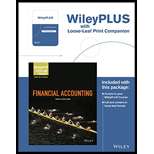
(a)
Bad debt expense:
Bad debt expense is an expense account. The amounts of loss incurred from extending credit to the customers are recorded as bad debt expense. In other words, the estimated uncollectible accounts receivable are known as bad debt expense.
Direct write-off method
This method does not make allowance or estimation for uncollectible accounts, instead this method directly write-off the actual uncollectible accounts by debiting bad debt expense and by crediting accounts receivable. Under this method, accounts would be written off only when the receivables from a customer remain uncollectible.
The amount to be reported as bad debt expense, if Company M uses the direct write-off method of accounting for
(b)
The amount of bad debts expense would be recorded by Company M, under allowance method.
Allowance method:
It is a method for accounting bad debt expense, where uncollectible accounts receivables are estimated and recorded at the end of particular period. Under this method, bad debts expenses are estimated and recorded prior to the occurrence of actual bad debt, in compliance with matching principle by using the allowance for doubtful account.
Bad debt expense:
Bad debt expense is an expense account. The amounts of loss incurred from extending credit to the customers are recorded as bad debt expense. In other words, the estimated uncollectible accounts receivable are known as bad debt expense.
(c)
The amount of bad debt expense that would be recorded by Company M.
(d)
To describe: The weakness of reporting bad debt expense under direct write-off method.
Want to see the full answer?
Check out a sample textbook solution
Chapter 8 Solutions
Financial Accounting, 10e WileyPLUS Registration Card + Loose-leaf Print Companion
- Salvador Manufacturing estimates that annual manufacturing overhead costs will be $842,400. Estimated annual operating activity bases are direct labor costs of $496,000, direct labor hours of 41,200, and machine hours of 90,400. Compute the predetermined overhead rate for each activity base: a. Overhead rate per direct labor cost b. Overhead rate per direct labor hour c. Overhead rate per machine hourarrow_forwardI need help in this question . accounting.arrow_forwardNeedarrow_forward
- Please give me answer with accounting questionarrow_forwardWhat is the correct answer with accounting questionarrow_forwardGrouper Corporation purchased machinery on January 1, 2025, at a cost of $264,000. The estimated useful life of the machinery is 4 years, with an estimated salvage value at the end of that period of $31,400. The company is considering different depreciation methods that could be used for financial reporting purposes. (a) Your answer is partially correct. Prepare separate depreciation schedules for the machinery using the straight-line method, and the declining-balance method using double the straight-line rate. STRAIGHT-LINE DEPRECIATION epreciation Rate 50 % do do % End of Year Annual Depreciation Expense Accumulated Depreciation Book Value +A 58150 $ +A % do do % 58150 58150 58150 +A $ 232600arrow_forward
- I want helparrow_forwardSolve thisarrow_forwardA company analyzing its break-even point for a product with a selling price of $85 per unit. The variable cost per unit is $53, and the fixed costs are $187,000 per year. If the company wants to achieve a profit of $76,000, how many units must it sell to meet this profit goal? (Round answer to nearest unit)arrow_forward

 AccountingAccountingISBN:9781337272094Author:WARREN, Carl S., Reeve, James M., Duchac, Jonathan E.Publisher:Cengage Learning,
AccountingAccountingISBN:9781337272094Author:WARREN, Carl S., Reeve, James M., Duchac, Jonathan E.Publisher:Cengage Learning, Accounting Information SystemsAccountingISBN:9781337619202Author:Hall, James A.Publisher:Cengage Learning,
Accounting Information SystemsAccountingISBN:9781337619202Author:Hall, James A.Publisher:Cengage Learning, Horngren's Cost Accounting: A Managerial Emphasis...AccountingISBN:9780134475585Author:Srikant M. Datar, Madhav V. RajanPublisher:PEARSON
Horngren's Cost Accounting: A Managerial Emphasis...AccountingISBN:9780134475585Author:Srikant M. Datar, Madhav V. RajanPublisher:PEARSON Intermediate AccountingAccountingISBN:9781259722660Author:J. David Spiceland, Mark W. Nelson, Wayne M ThomasPublisher:McGraw-Hill Education
Intermediate AccountingAccountingISBN:9781259722660Author:J. David Spiceland, Mark W. Nelson, Wayne M ThomasPublisher:McGraw-Hill Education Financial and Managerial AccountingAccountingISBN:9781259726705Author:John J Wild, Ken W. Shaw, Barbara Chiappetta Fundamental Accounting PrinciplesPublisher:McGraw-Hill Education
Financial and Managerial AccountingAccountingISBN:9781259726705Author:John J Wild, Ken W. Shaw, Barbara Chiappetta Fundamental Accounting PrinciplesPublisher:McGraw-Hill Education





